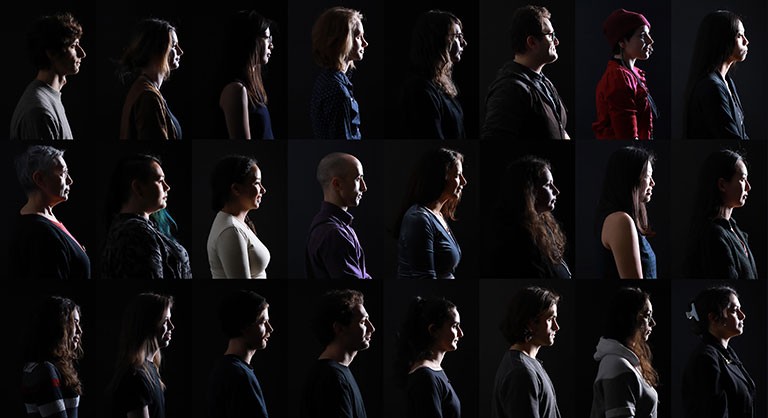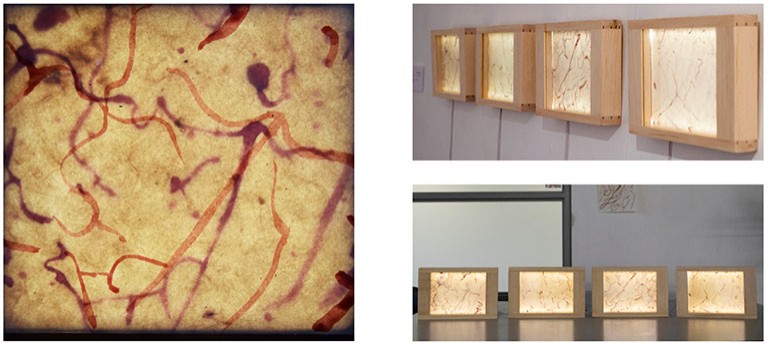Artists and neuroscientists collaborate on a year-long art-science project
 Bettina Forget: “The Convergence course is a testament to what can be achieved when artists and scientists come together."
Bettina Forget: “The Convergence course is a testament to what can be achieved when artists and scientists come together."
Three years ago, Cristian Zaelzer created the Convergence Initiative to perform a simple test: what would happen if he gave artists and scientists the time, space and resources to collaborate on a research-creation project?
“We wanted to establish a link between neuroscience and the art community,” says Zaelzer, who holds a PhD in molecular and cell biology, and is the president and founder of the Convergence Initiative.
“Through the initiative, we work to foster collaborations between science and art, and make neuroscience research accessible to the general public.”
Zaelzer and Bettina Forget, a PhD student in Concordia's Department of Art Education, recently finished teaching a six-credit Convergence course that ran through the 2018-19 academic year. Their course brought students together from the Faculty of Fine Arts at Concordia and the Brain Repair and Integrative Neuroscience Program (BRaIN) at the McGill University Health Centre (MUHC).
‘Both contemporary art and science look at how nature works’
Zaelzer met Forget through a chance encounter at a conference. Forget is also the founder and owner of the Visual Voice gallery, a space with a mandate to show work that intersects art with science.
She sees meaningful cultural exchanges through these intersections.
“When people think of art, they think of reclining nudes and landscapes,” Forget says.
“But contemporary artists ask research questions. Both contemporary art and science look at how nature works, and connect it to the human condition.”
Zaelzer agrees. He believes that the students have more in common than they realize.
“The idea is to give students the opportunity to explore each other's silos, and to pull these two worlds together and create something in common.”
During the course, students were asked to imagine each other's disciplines, and to examine their internalized perspectives of both scientists and artists. Through engaged projects, readings and site visits, they formed a shared knowledge and vocabulary.
The course's outcomes were recently on display in two exhibitions at the Visual Voice Gallery and Concordia's Black Box. Their works filled the spaces with screens, lightboxes, sculptures, prints, plants and even a game.
Each work of art was produced collaboratively by a scientist and artist.
‘My partner saw certain nuances coming from the patient that she had never considered before’
 Self Flow: a series of four lightboxes by incoming art therapy student Lily Jiménez-Daboub and neuroscience PhD candidate Liam O’Leary.
Self Flow: a series of four lightboxes by incoming art therapy student Lily Jiménez-Daboub and neuroscience PhD candidate Liam O’Leary.
The Cookie Theft: Case Studies, 2019 is a series of screen prints by speech pathologist Marielle McCrum and artist Rochelle Panginaban, who also has a background in psychology. The work looks at a common test for speech language pathology called the cookie theft test. Patients describe the image of children stealing cookies from a jar, and their descriptions can give clues to what condition they have.
The work presents several didactic prints. One half is transcribed text from patient interviews, which resembles dada poetry in letterpress style. The other is the visualization of the patient’s description, which vary widely. One print shows an image with each element described as brooms, with another vividly exaggerating the scene.
“By displaying the responses visually, my partner saw certain nuances coming from the patient that she had never considered before,” Panginaban says.
“Sitting down and looking gives you a different perspective of what’s going on.”
Another work, Self Flow, is a series of four lightboxes by incoming art therapy student Lily Jiménez-Daboub and neuroscience PhD candidate Liam O’Leary, who studies the effects of mental health on the brain.
“There is a theory based on animal studies that depression changes your brain, making blood vessels smaller and slowing blood flow to critical areas,” explains O’Leary.
Using four of O’Leary’s images from microscopic photos, Jiménez-Daboub painted the works using only her own blood to make a statement about her own dealings with mental illness. The blood, used to represent the vessels, will change colour over time, relating back to the nature of change as an organic process.
‘A testament to what can be achieved when artists and scientists come together’
The difference between this year’s class and the first Convergence class in 2016-17 was that this year, McGill University students could enrol in the course for credit. In previous years, they were the artist’s subjects.
The scientists took more of an active role in making the artworks this year, says Zaelzer, and the artists really took the science to heart.
“Watching the students interact with the work over the course of the year, started to become unclear who the individual artists and scientists were. Everyone spoke with shared authority. They both used the language of art and science to effectively present the audience with their ideas,” he says.
“The Convergence course is a testament to what can be achieved when artists and scientists come together, make their work accessible, and engage in meaningful research,” adds Forget.
Learn more about Concordia's Faculty of Fine Arts.